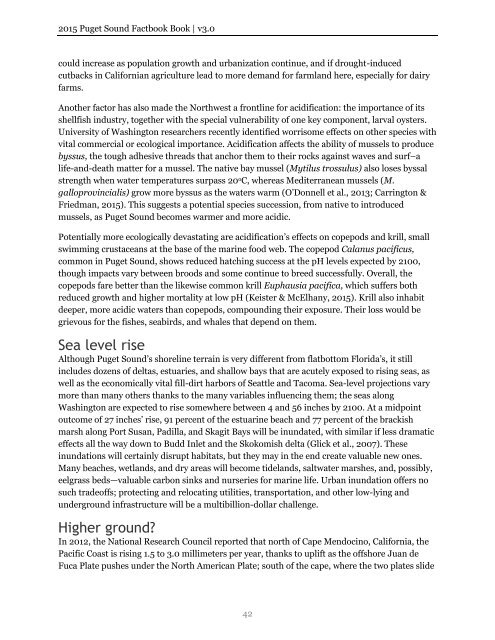You also want an ePaper? Increase the reach of your titles
YUMPU automatically turns print PDFs into web optimized ePapers that Google loves.
2015 <strong>Puget</strong> <strong>Sound</strong> Factbook Book | v3.0<br />
could increase as population growth and urbanization continue, and if drought-induced<br />
cutbacks in Californian agriculture lead to more demand for farmland here, especially for dairy<br />
farms.<br />
Ano<strong>the</strong>r factor has also made <strong>the</strong> Northwest a frontline for acidification: <strong>the</strong> importance of its<br />
shellfish industry, toge<strong>the</strong>r with <strong>the</strong> special vulnerability of one key component, larval oysters.<br />
University of Washington researchers recently identified worrisome effects on o<strong>the</strong>r species with<br />
vital commercial or ecological importance. Acidification affects <strong>the</strong> ability of mussels to produce<br />
byssus, <strong>the</strong> tough adhesive threads that anchor <strong>the</strong>m to <strong>the</strong>ir rocks against waves and surf–a<br />
life-and-death matter for a mussel. The native bay mussel (Mytilus trossulus) also loses byssal<br />
strength when water temperatures surpass 20 o C, whereas Mediterranean mussels (M.<br />
galloprovincialis) grow more byssus as <strong>the</strong> waters warm (O’Donnell et al., 2013; Carrington &<br />
Friedman, 2015). This suggests a potential species succession, from native to introduced<br />
mussels, as <strong>Puget</strong> <strong>Sound</strong> becomes warmer and more acidic.<br />
Potentially more ecologically devastating are acidification’s effects on copepods and krill, small<br />
swimming crustaceans at <strong>the</strong> base of <strong>the</strong> marine food web. The copepod Calanus pacificus,<br />
common in <strong>Puget</strong> <strong>Sound</strong>, shows reduced hatching success at <strong>the</strong> pH levels expected by 2100,<br />
though impacts vary between broods and some continue to breed successfully. Overall, <strong>the</strong><br />
copepods fare better than <strong>the</strong> likewise common krill Euphausia pacifica, which suffers both<br />
reduced growth and higher mortality at low pH (Keister & McElhany, 2015). Krill also inhabit<br />
deeper, more acidic waters than copepods, compounding <strong>the</strong>ir exposure. Their loss would be<br />
grievous for <strong>the</strong> fishes, seabirds, and whales that depend on <strong>the</strong>m.<br />
Sea level rise<br />
Although <strong>Puget</strong> <strong>Sound</strong>’s shoreline terrain is very different from flatbottom Florida’s, it still<br />
includes dozens of deltas, estuaries, and shallow bays that are acutely exposed to rising seas, as<br />
well as <strong>the</strong> economically vital fill-dirt harbors of Seattle and Tacoma. Sea-level projections vary<br />
more than many o<strong>the</strong>rs thanks to <strong>the</strong> many variables influencing <strong>the</strong>m; <strong>the</strong> seas along<br />
Washington are expected to rise somewhere between 4 and 56 inches by 2100. At a midpoint<br />
outcome of 27 inches’ rise, 91 percent of <strong>the</strong> estuarine beach and 77 percent of <strong>the</strong> brackish<br />
marsh along Port Susan, Padilla, and Skagit Bays will be inundated, with similar if less dramatic<br />
effects all <strong>the</strong> way down to Budd Inlet and <strong>the</strong> Skokomish delta (Glick et al., 2007). These<br />
inundations will certainly disrupt habitats, but <strong>the</strong>y may in <strong>the</strong> end create valuable new ones.<br />
Many beaches, wetlands, and dry areas will become tidelands, saltwater marshes, and, possibly,<br />
eelgrass beds—valuable carbon sinks and nurseries for marine life. Urban inundation offers no<br />
such tradeoffs; protecting and relocating utilities, transportation, and o<strong>the</strong>r low-lying and<br />
underground infrastructure will be a multibillion-dollar challenge.<br />
Higher ground?<br />
In 2012, <strong>the</strong> National Research Council reported that north of Cape Mendocino, California, <strong>the</strong><br />
Pacific Coast is rising 1.5 to 3.0 millimeters per year, thanks to uplift as <strong>the</strong> offshore Juan de<br />
Fuca Plate pushes under <strong>the</strong> North American Plate; south of <strong>the</strong> cape, where <strong>the</strong> two plates slide<br />
42


